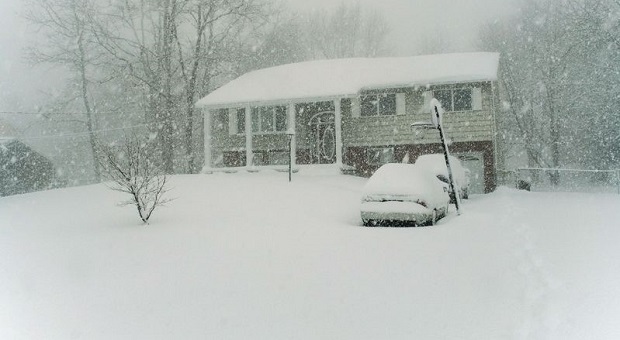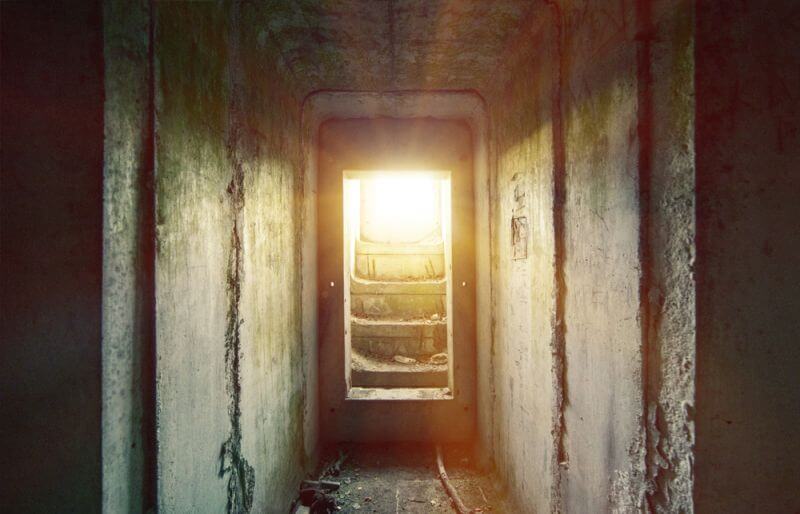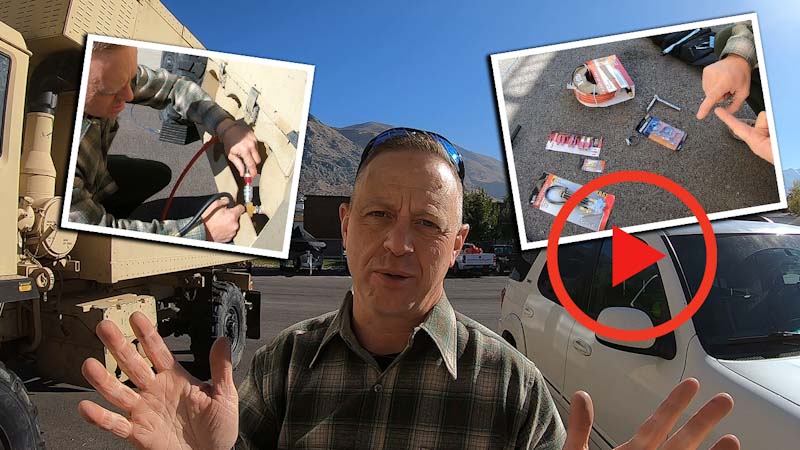Blizzard can be annoying when you want to go out or attend to any number of matters. But seems like snow storms still have something to say, if you take a look at the weather forecast for the Midwest.
If the power goes out during a blizzard it can also be very dangerous. Even if you have an alternative power system such as solar panels or windmills, the odds are very high they will not work in these conditions.
Here are some things you can do to obtain water, heat up food, preserve refrigerated foods, and manage other needs without electricity.
1. Candle Heaters
Candle heaters are very simple devices that make use of three clay pots, a bolt, some metal washers and a fireproof stand. Add 1 to 4 tea lights or votive candles to begin generating heat. You can purchase premade “Kandle Heaters” or make your own.
Make sure that the ceramic flower pots are not glazed, and that you choose zinc free bolts and washers. Candle heaters can easily be assembled in under 10 minutes and will begin heating up a room in a matter of moments. Since the outer pot will get fairly hot, you can do the following:
- Warm up foods such as canned soup or anything that has not been frozen
- If the outermost pot is large enough, you can warm up a cup of water.
If you are going to use the candle heater as a cooker, make sure that you use a ceramic saucer on top. You will also need to make sure that the heater base will not collapse under the added weight. Also be sure that the saucer is resting on 3 or 4 supports that will keep it in place, as the center bolt can cause the saucer to disbalance.
Before using a candle heater, check that the clay pots are as dry as possible since any moisture will impede heat flow. To achieve this, put the clay pots in a conventional oven and let them heat up until they dry out. It is best to do this as close to the time when you will use the candle heater so that moisture does not build back up in the walls of the pots.
2. Rocket Stoves
All different kinds of rocket stoves rely on a small inner chamber that optimizes burning of flammable materials and an outer shell that radiates heat. The smallest and simplest rocket stoves can be made from tin cans, while larger and more complex ones might include chimneys and space for a cooking oven.
If you have not built a suitable rocket stove, you can still use the tin can version in a blizzard. Here are some basic instructions for building a tin can rocket stove:
Video first seen on Desert Sun 02
If you have plenty of rubbing alcohol on hand, you can also use tin cans or other metal tins to build a very simple alcohol stove.
Video first seen on LlegaWeapon And DIY
You can also find a lot of resources online, about building more complex stoves.
From a DIY perspective, never forget that “fins” or thin strips of metal diffuse heat more efficiently than a solid shape. If you have an extra can, or even some tinfoil, you can make fins and then fit them around the can to see if they will improve heat disbursement.
Regardless of the rocket stove design that you choose, it can accommodate paper logs, wood, coal, and just about anything else that will burn. Just remember that you will have to remove the ashes on a regular basis.
Small tin can rocket stoves reach a higher temperature than candle heaters, so they can be used to boil water and fry foods more easily. They can also be used for heating up a room, however all of these actions will also generate a lot more smoke than you would get from candles. Therefore, your activities will be limited by your ability to vent the smoke out and get fresh air in.
Some ways to get around this problem include:
- Make a large enough stove, or outer shell so that you can create a fully functional chimney or vent. You can also look for ways to create a portable chimney or vent system to use in blizzard or crisis situations where you cannot keep a permanent chimney in place. Be sure that you know how to build the chimney safely, and also set the stove pipe up so that it does not create unintended fires or other hazards.
- Use the rocket stove outdoors and in a safe location where it will not set anything flammable on fire. Next, build a water pipe system that will be used to run cold water out to the stove where it can be heated up, and then pumped back in to heat up the house when the water is hot. You will need to insulate the pipes so that as much heat comes into the house as possible, and also make sure that the pumps do not require electricity to operate. This may involve figuring out how to make gravity powered pumps and motors that will work in this situation.
3. Cinder Block Stoves
Overall, cinder blocks stoves are often considered in the same category as rocket stoves. They are very easy to build, and can be expanded into multiple burners or large enough sizes to accommodate just about any task. You can also add an inner metal chamber so that you get the benefits of a rocket stove in this design.
As with other stoves, cinder block variants require adequate ventilation for safe usage. Because of their size, cinder block stoves lend themselves better outdoor use and providing more heat than other designs. Here are some things you can do with basic cine
4. Conventional Propane Stoves
If you are looking for a solution that doesn’t require any building or prep work, propane stoves may be your best option in a blizzard. These stoves are safe, easy to manage, and can be used to cook just about any kind of food.
As with other stoves, you will still need adequate ventilation, as the fumes from these stoves can be as deadly as from any other fire. Even if a stove is rated for indoor use, do not assume that a room with winterized windows and/or doors will let enough air in to keep you safe.
Unlike other stove types, you will need propane cylinders to run these stoves. You should have enough propane on hand to cook for at least 4 weeks. Depending on where you live, a power outage caused by a blizzard may only last a few hours, while in other areas, the outage may last for weeks on end.
5. Kerosene Stoves
When it comes to heating up a room without using electricity, few methods can rival a kerosene heater. As long as you have plenty of ventilation, you will also be safe from the fumes. You can rely on this type of heater to provide a warm place in the room as well as a place where you can cook and heat up water. Overall, you will also find that kerosene is a good bit cheaper than propane.
If you have never used a kerosene stove before, make sure that you start off with a properly mounted wick. You may also have to trim the wick back a bit so that it is as even as possible. When the wick is at the right height and even, the stove will not produce any visible smoke and very little smell.
However, it will still be making fumes that include carbon monoxide. If you see smoke or smell a lot of kerosene, do the following:
- Look down from the top grates of the stove so that you can see the top of the burner. The flames should be evenly disbursed all the way around without any breaks. You should be able to see the center metal portion of the burner. If the flames are obstructing the view, then they are too high. Lower the wick to bring them back under control.
- If some of the wick is lit, but other parts aren’t, then shut the stove down and open up the cage. Look carefully at the wick to see if it is even all the way around. In some cases, you can get away with opening up the burner (after it cools) and pulling the wick to make it even. In other cases, you may have to trim the wick to make it even. Always refer to the owner’s manual to find out how to carry out these operations for your specific heater.
- If the wick is even but the flame is too low or not all the way around, you can turn the wick up a little bit to see if that helps.
6. Compost Pile Heaters
If you have ever created a viable compost pile, then you also know it generates a good bit of heat. As long as the pile is sheltered and has plenty of materials to transform, you should get enough heat from the core of the pile to heat up water and your home. Just keep pipes filled with water in the core of the pile. As with other water heat systems, you will also need gravity powered pump motors or some other mechanism to keep the water moving into your home.
Unlike many other systems, this is one of the few that will enable you to continue getting hot water from the tap as long as you have the system set up to cut into the hot water line.
Even though compost pile heaters take a bit more work than others they have many advantages that will make them work well in a blizzard:
- You will never need to worry about toxic fumes in the home
- If they have been providing heat and hot water in colder temperatures already, they will also work perfectly in a blizzard
- You will always have plenty of compost to fertilize container gardens as well as outdoor ones.
7. Paper Logs and Burning Wood
If you have a wood stove with a working chimney, most of your heating and cooking problems during a blizzard will already be solved. Even if you do not have enough wood on hand, you can roll up newspapers and other types of scrap paper to make paper logs.
Without a proper fireplace, you are best served by building wood fires outdoors. At least you will be able to cook and heat up water. If you have a dedicated firepit or plan to build one, install copper tubes or other pipes that can be used to generate hot water.
Some places in Canada and other areas are looking to outlaw wood stoves, and similar laws might also make their way to where you live or have your homestead. Attend all board meetings and get involved in local governance matters.
Always take action to investigate the financial dealings of politicians and make any financial bias known to your neighbors, the media, and to others through social networking.
If you do not take part and speak out at the most basic level of local government, the power vested in you as a citizen will become more eroded than it already is. Never forget that government is what you make of it. When you do not fully investigate those who enact laws on your behalf, they will do what is best for them and their cronies instead of you.
8. Keeping Foods Cold or Frozen
During a blizzard, many people are surprised to find that food in the freezer will defrost, and items in the refrigerator will go bad. In most cases, if you do not open the door of the freezer or refrigerator, it will only hold a viable temperature for 24 – 48 hours.
Before that window closes, you must have some kind of alternative refrigeration method on hand. Here are some ways that you can keep foods cold:
- Take advantage of the snow already on the ground. You can build an ice chest by piling up snowballs or simply dig into the snow to create a storage area. Just remember to put a flag or pole near the cache so that you know where to find it again.
- To preserve eggs, cheese, and other items that don’t do well when frozen, you can put them outdoors in thermal chests, or in an unheated garage or shed. Watch temperatures carefully so that the foods do not become frozen or too warm.
- Use a zeer pot indoors for items that need a narrower cooling temperature band.
- Fill an ice chest with ice and salt. This system will freeze items and also keep them frozen with ease.
9. Passive Heating Methods
When you live in a tiny apartment or some other constrained location, it may not be possible to have a kerosene heater or many of the other devices mentioned in this article. If you can only keep an alcohol burner and a candle heater, then you may still need to use passive heating methods to stay warm. Here are some things that may help:
- Bundle up in thin layers of clothing. You can start off with 2 or 3 layers of synthetic material (avoid cotton) and then bundle fleece, sweaters and coats on top of that.
- Seal off all doors and windows with plastic and duct tape. If you do not have window frames with plastic already made, then just staple and tape the plastic over the windows. If you must, use layers of garbage bags to seal the windows. You can also use newspapers in door frames to keep the cold out.
- If you have a camping tent, put that in the middle of a room to create a smaller area to heat up. Use camping blankets to cover yourself up and keep as much body heat in as possible. Plastic shopping bags will also help insulate you. Put them outside your socks and inside your shoes to help keep your feet warm. Just be aware that moisture will build up inside the plastic, so you will need to air your feet out every few hours to avoid problems.
- If other people are with you, or animals, huddle together to preserve as much body heat as possible.
- Use candle heaters or alcohol heaters to generate hot water. If you put a tent up in the middle of a room, you can bring that hot water into the tent to disburse heat. You can also heat up fire safe bricks or stones and bring them into the tent area to radiate heat in a safe manner. As a word of caution, to not simply assume that any stone on the ground can be heated up safely. Even if they do not tend to accumulate water, they may have chemicals in them that will emit toxic fumes upon being heated up. You are better served by purchasing bricks and stones that are certified safe to use for this purpose rather than wind up dead from the fumes. Alternatively, you may also be able to find survival courses that will teach you how to choose and prepare stones for this purpose. If you do take these courses, also remember that adding water to produce steam is a whole other area of expertise. Do not use these methods unless you are confident of your skills and know enough about the rocks you are dealing with.
10. Staying Safe in a Sealed Room or Area
Once the power goes out and temperatures begin to drop, it is very easy to panic and forget some of the most basic safety rules.
In this case, many people wind up dead or with permanent brain damage because they forgot about adequate ventilation. Whenever you have fire, there must be a way for smoke to escape and fresh air to get in. If your windows are all tightly bottled up and every draft sealed off, then you will have a very hard time using any kind of fire indoors.
When it comes to staying safe during a blizzard, also remember that fires can get out of control when you don’t watch them. You should always keep firefighting equipment on hand and learn how to use it. Even something as attractive and safe as a candle heater can generate sparks or start an unintended blaze.
There is no substitute for practicing with any device that you may use to generate heat during a blizzard. It is also equally important to make sure that fires are attended at all times and you have adequate detection systems on hand and functioning in order to detect smoke and carbon monoxide. In this case, if you have decided to close off certain room, then make sure that the room you choose to operate a fire based heater has a detector in an area where it can actually pick up on the fumes before they render you unconscious or otherwise unable to get out of the situation.
When the power goes out during a blizzard you are bound to feel distressed. Aside from the fact that the heating system probably won’t work, you may also be unable to cook, get water, prepare food, or tend to other matters. No matter whether the commercial power grid goes down or your alternative power system goes offline, there are still ways to meet basic needs without electricity.
While these methods may take a bit of time to assemble, or take a bit of work to use, they will still get you through the blizzard. As you work with these systems during the relatively short time that a blizzard is ongoing, it will also give you some ideas about how these systems will work in a larger scale power outage.
Remember that as bad as this situation may be, you can still use the scenario to improve your survival skills and determine which kinds of equipment and skills should be further cultivated.
This article has been written by Carmela Tyrell for Survivopedia.









Pingback:10 Things To Replace Power During A Blizzard | Prepper's Survival Homestead | February 5, 2016
|
Willam pearsall | February 5, 2016
|
Instead of “Airing” your plastic bag covered feet, just use several changes of socks.
Pingback:10 Things To Replace Power During A Blizzard | NewZSentinel | February 5, 2016
|
Evan | February 5, 2016
|
To me these items should already be on a shelf ready for any type of situation. If you are going to use any of these stoves they should be pre built and tested before hand. Always be familiar with the operation and its limits as a house fire will add more misery to an already bad situation. Another alternative is a fuel tablet stove which can be found in any prep type company (one cheap one comes to mind…CH Kadels) even our Walmart sells one. around 5 to 7 dollars and tablets 3 to 4 dollars.
A five gallon bucket (Home Depot $5 bucks) an old toilet seat and some heavy duty trash bags also high on the list as we all gotta go.
Sallie Dodd Butters | February 5, 2016
|
Some very cool ideas here! Alaska has some crazy weather, earthquakes, forest fires and volcanoes….after 40 yrs +…about 30 of them without plumbing…1 without electricity…. I’ve known or used quite a few ideas. Thanks!
Pingback:10 Things To Replace Power During A Blizzard | Bsn Global News | February 5, 2016
|
Pingback:Survival News 02/05/16 | Survival Pulse | Daily Survival & Prepper News | February 6, 2016
|
Pingback:10 Things To Replace Power During A Blizzard | TheSurvivalPlaceBlog | February 9, 2016
|